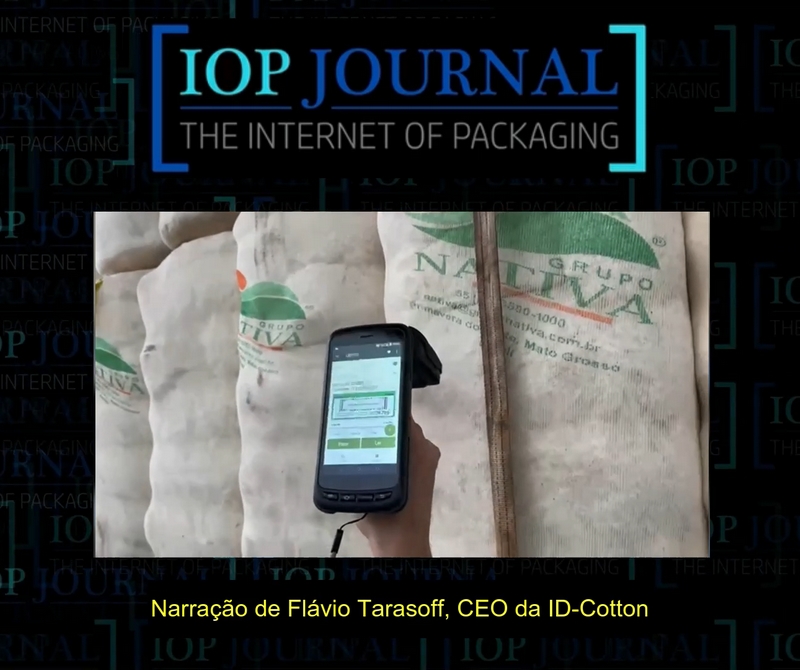Edson Perin
For more than a year, the IoP Journal has been following and reporting on advances in radio frequency identification (RFID) technology at ID-Cotton at the Brazilian cotton sector. On September 21, 2021, another historic achievement of the company reached the entire agribusiness segment in Brazil. ID-Cotton’s technology was used to ship the world’s first 100 per cent traceable cotton cargo, an operation based at the Port of Santos, Brazil, and bound for Vietnam, where the spinning mill will have the entire data of the origin of the Brazilian raw material.
Flávio Tarasoff, CEO of ID-Cotton, set the tone for the achievement. “Today, we are certain that we have contributed to a real milestone in the history of Brazilian cotton: shipping the first 100% tracked cargo of cotton lint in the world, with ID-Cotton’s RFID technology. There were many challenges and, of course, we have the support of many people, companies and entities that are part of this chain. The cargo will go to Vietnam and will be tracked to the spinning mill that will carry out the processing, taking with it all its origin history, from the field to the port of destination”.

Click here and watch the demonstration recorded by ID-Cotton and narrated by Flávio Tarasoff, CEO of ID-Cotton [in Portuguese].
ID-Cotton has been developing for four years an RFID solution to enable the cotton to be traced from harvest to processing. Tarasoff says that this is a product aimed at the annual harvest. “We started with a production unit and today we have more than 45 using the solutions”. The Bom Futuro Agro Group, Brazil’s largest cotton producer, was a pioneer in the use of ID-Cotton. Then came the units of the Scheffer, Amaggi, Locks and Cortezia Agro Groups, all from Mato Grosso, which together represent more than 20% of lint production in Brazil.
All management before ID-Cotton’s RFID system was carried out in the cotton sector through labels and manual processes such as bar codes. The RFID deployment follows the passive EPC UHF standard, from GS1. “The main benefit is the traceability of production, operational management, storage and increased gain in the classification of the lint, when using all ID-Cotton tools”, he guarantees.
Headquartered in Cuiabá (MT), ID-Cotton centralizes the production, operation, support and sales of the systems at its headquarters. “In addition, this year we formed ID-Cotton Agribusiness LLC, in the United States, based in the city of Doral, Florida,” says Tarasoff. “The location is strategic, as it is close to the local port and airport, and will concentrate the manufacture of equipment to distribute in the international market, with the kits already ready. The proximity to Texas is also a facilitator, as there is the largest cotton planted area in the US”.
ID-Cotton’s solution for cotton traceability aims to combat flaws in the processes for marking and identifying the bales harvested. In addition, they eliminate manual labels, handwritten spreadsheets, “spray painting on canvas and other old methods of identifying producer, farm, variety, field, border and contaminants. The ID-Cotton system facilitates yard management and processing, avoiding the contamination of cotton varieties, guaranteeing the final quality of the product and also the price of the cotton lint arroba.
In practice, after the cotton is harvested, the RFID tags – inserted in the cotton rolls – are read and recognized by means of a tablet with the ID-Cotton system. This information is synchronized with the company’s ERP, which, in a second moment, automatically reads the loads of these rolls through an RFID portal when transferring the cotton crop, discharging the cotton from the crop and transferring this stock into the processing unit.
“One of the most important factors”, explains Tarasoff, “was the technological change, because before the cotton harvest and transport, barcode labels were used, which had several flaws, from lack of reading to registration errors, since the process was done manually”. The solution developed by ID-Cotton offers integration with management systems (ERP). “By facilitating the marking and identification of bales in the field, the ID-Cotton system impacts on increased productivity and reduces staff in the field.”
With bales receiving a unique identification, transport management becomes more agile, as does the real-time location of each package. “Our technology reduces time in the yard and the use of the scale”, he attests. “Finally, the system saves on personnel, labels and manual processes, guaranteeing real gains in the final value of the cotton”. As it is modular, ID-Cotton serves the major players in agribusiness and can also be used by farmers, cotton units, cooperatives, among others.
“This year, we are importing the data that were recorded on the canvas tags for the new RFID tags, which will be added to the cotton lint, which can be used for blockage management, laboratory analysis tracking, cargo management, loading and unloading and classification of the lint in the next production chain, which are the spinning mills”.
The RFID readings were related to the mass, density, structure of the vehicles that handle the cargo, weather conditions, rain, calm, humidity, position of the bale on the trailer, variety of trailers with diverging heights and volumes, angles of attack of the scales and failures in the processes of other manufacturers. “Since it is a completely new technology, there were many challenges, most of which were focused on transport”, attests Tarasoff.
The differences in tare – weight of the truck without the load – and structure of the vehicles, as well as the variety of trailers with different heights and volumes and the position of the cotton bales, were analyzed to carry out the readings without fail. “Weather conditions”, says Tarasoff, “such as rain, sun, serene and relative humidity also influence and the system had to take these variations into account”. To carry out the weighing at the stations, it was necessary to check all angles of attack of the scales on the roads so that there were no reading errors.



















